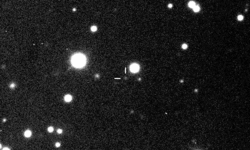Astronomy:Sponde
 Discovery images of Sponde by the Canada-France-Hawaii Telescope in December 2001 | |
| Discovery[1] | |
|---|---|
| Discovered by | Scott S. Sheppard et al. |
| Discovery site | Mauna Kea Obs. |
| Discovery date | 9 December 2001 |
| Designations | |
Designation | Jupiter XXXVI |
| Pronunciation | /ˈspɒndiː/ |
| Named after | Σπονδή Spondē |
| S/2001 J 5 | |
| Adjectives | Spondean /ˌspɒnˈdiːən/ |
| Orbital characteristics [3] | |
| 23487000 km | |
| Eccentricity | 0.312 |
| Orbital period | −734.89 days[2] |
| Inclination | 151.0° |
| Satellite of | Jupiter |
| Group | Pasiphae group |
| Physical characteristics | |
| Mean diameter | 2 km |
| Apparent magnitude | 23.0 |
| Absolute magnitude (H) | 16.7[2] |
Sponde /ˈspɒndiː/, also known as Jupiter XXXVI, is a natural satellite of Jupiter. It was discovered by a team of astronomers from the University of Hawaii led by Scott S. Sheppard in 2001, and given the temporary designation S/2001 J 5.[4][1]
Sponde is about 2 kilometres in diameter, and orbits Jupiter at an average distance of 24,253,000 km in 734.89 days, at an inclination of 154° to the ecliptic (156° to Jupiter's equator), in a retrograde direction and with an eccentricity of 0.443.
It was named in August 2003 after one of the Horae (Hours), which presided over the seventh hour (libations poured after lunch).[5] The Hours, goddesses of the time of day but also of the seasons, were daughters of Zeus (Jupiter) and Themis.
It belongs to the Pasiphae group, irregular retrograde moons orbiting Jupiter at distances ranging between 22.8 and 24.1 Gm, and with inclinations ranging between 144.5° and 158.3°.
References
- ↑ 1.0 1.1 MPEC 2002-J54: Eleven New Satellites of Jupiter 2002 May 15 (discovery and ephemeris)
- ↑ 2.0 2.1 "M.P.C. 111777". Minor Planet Circular. Minor Planet Center. 25 September 2018. https://minorplanetcenter.net/iau/ECS/MPCArchive/2018/MPC_20180925.pdf.
- ↑ S.S. Sheppard (2019), Moons of Jupiter, Carnegie Science, on line
- ↑ IAUC 7900: Satellites of Jupiter 2002 May 16 (discovery)
- ↑ IAUC 8177: Satellites of Jupiter, Saturn, Uranus 2003 August 8 (naming the moon)
 |

